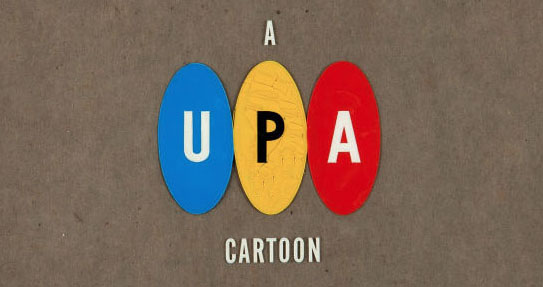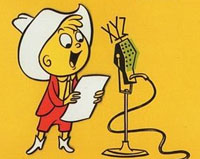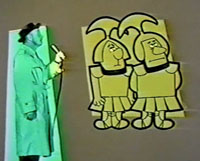
I got a chance to do a lengthy interview with Bill Scott on September 3, 1982 where we spent hours talking not only about his legendary work with Jay Ward but some other things like his time at Warner Brothers and UPA
While most people are aware of his long and successful association with Producer Jay Ward (including supplying the voice of Bullwinkle Moose), Scott had a varied career in animation and when I talked with him he already had forty years worth of experience under his belt. He worked at Warners, Clampett and other studios.
I had met Scott through his work with ASIFA-Hollywood in the Seventies and when I requested an interview, he invited me up to his house where we spent hours going over all sorts of things.
Bill Scott passed away on November 29, 1985 in his sleep at his home in Tujunga, California at the age of 65.
Jim Korkis: So after you got laid off from being a writer on “Time for Beany” puppet show with Bob Clampett, you worked at UPA (United Productions of America)?
 Bill Scott: I had worked with some of these people before. I guess the first thing I worked on was the second Mr. Magoo short (“Spellbound Hound” 1950). I had to help develop the character with more premises and so forth. Then I worked on the adaptation of “Gerald McBoing Boing” (1951) which was based on a story by Ted “Dr. Seuss” Geisel. We changed a lot of the lines that were in there. Some of them were very much like Geisel and you couldn’t tell where Geisel leaves off and we started. It was a very successful picture and of course, it was fun to do.
Bill Scott: I had worked with some of these people before. I guess the first thing I worked on was the second Mr. Magoo short (“Spellbound Hound” 1950). I had to help develop the character with more premises and so forth. Then I worked on the adaptation of “Gerald McBoing Boing” (1951) which was based on a story by Ted “Dr. Seuss” Geisel. We changed a lot of the lines that were in there. Some of them were very much like Geisel and you couldn’t tell where Geisel leaves off and we started. It was a very successful picture and of course, it was fun to do.
JK: Was writing at UPA different than at Warners?
BS: To begin with, you never mentioned Warners! The kiss of death at UPA was to be considered a Warner Brothers writer. They were considered clothesline gag people with lots of violence. At UPA, you had to be able to justify your humor, which was difficult to do. You couldn’t write a big blow-off for your joke and pay it off with a big animation tag, or a pose.
They wouldn’t let you do it even though it was common at Warners. You have to remember that when I was working at Warners and at UPA, writers were still pretty low on the totem pole. In some ways, I dislike the term “story man”. We’re writers. But I guess being a “story man” is better than being a “gag man” which was a term that lasted through the Forties. It’s writers who go about inventing the worlds that never previously existed.
JK: Do you have a particular favorite among your UPA efforts?
 BS: I guess if I were limited to one to look at over and over again, it would be “The Tell Tale Heart” (1953). I worked with Fred Gable on that one. It was my job to adapt the Edgar Allan Poe story. I’d pick a phrase here and there and write Poe-like stuff to bridge the gaps. Ted Parmelee (an animation director who later worked for Jay Ward) and (designer) Paul Julian really did a superb job. Paul was into this Daliesque thing.
BS: I guess if I were limited to one to look at over and over again, it would be “The Tell Tale Heart” (1953). I worked with Fred Gable on that one. It was my job to adapt the Edgar Allan Poe story. I’d pick a phrase here and there and write Poe-like stuff to bridge the gaps. Ted Parmelee (an animation director who later worked for Jay Ward) and (designer) Paul Julian really did a superb job. Paul was into this Daliesque thing.
We were fortunate enough to get James Mason to narrate the story and I got to direct him. I told him where I thought this could be different and that could be different and he’d hit it perfectly. It was a thrill to sit there and listen to this stuff.
JK: Wasn’t “The Tell Tale Heart” originally planned for 3-D?
BS: We first shot it in 3-D, however it was never released in this format. The design and the technique of the constant multiple fade, fade, fade, so that the lights and shapes change and move without any real motion has never been approached since. Nobody’s taken the time and trouble to fool with it.
JK: Where did you go after UPA?
BS: I worked freelance for a bit, then went to work with John Sutherland. Sutherland had an educational film company and made a niche in animation with major corporations. I had to write things like animated cartoons on why fishing laws are vital to us or about DuPont employee benefits which was designed primarily to steal the thunder from any kind of union organization.
Everybody at DuPont saw this great, cute picture about how well they’re going to be protected by the company. I wasn’t particularly proud of it. After about four years, I couldn’t stand it anymore. I tried to quit three times but John would stuff my mouth with money so I wouldn’t make any noise. I left on fairly good terms. When I quit I was making over seven hundred dollars a week.
JK: Then you came back briefly to UPA.
 BS: I was doing a lot of freelancing, including Quartet Films and Storyboard for commercials. I had been called back to UPA in 1956 to do some trouble shooting on the television show, The Boing Boing Show. It was very nice to be called back. I did not come in for a long period of time. I was supposed to look at every story in the place and try to figure out how to make it funny or how to make it better or how to add stuff to it. I couldn’t help it out very much. I met a lot of resistance from people who said my stuff was not funny and they weren’t going to use it. I think I was looked at like a great pain in the ass by most people who I was supposed to be helping.
BS: I was doing a lot of freelancing, including Quartet Films and Storyboard for commercials. I had been called back to UPA in 1956 to do some trouble shooting on the television show, The Boing Boing Show. It was very nice to be called back. I did not come in for a long period of time. I was supposed to look at every story in the place and try to figure out how to make it funny or how to make it better or how to add stuff to it. I couldn’t help it out very much. I met a lot of resistance from people who said my stuff was not funny and they weren’t going to use it. I think I was looked at like a great pain in the ass by most people who I was supposed to be helping.
JK: In 1959, the financially troubled UPA was sold to producer Henry Saperstein and you came back there again for a brief time.
BS: I worked on “1,001 Nights” (UPA’s first full length animated feature released in 1959) with Mr. Magoo. They wanted somebody who had worked with actors. It was a pretty good track, but it was a dull picture. Again, it was done fairly straight with very few animation jokes in it. By that time, Magoo had softened up considerably.
Pete Burness in later years said he was very sorry he did that. He listened to some people who told him that he should make Magoo more lovable and cuddly or audiences wouldn’t like him. I was doing fairly well but I don’t have the mentality for freelancing. I was always worried about last week or next week.


 Jim Korkis is an internationally respected animation historian who in recent years has devoted his attention to the many worlds of Disney. He was a columnist for a variety of animation magazines. With his former writing partner, John Cawley, he authored several animation related books including The Encyclopedia of Cartoon Superstars, How to Create Animation, Cartoon Confidential and Get Animated’s Animation Art Buyer’s Guide. He taught animation classes at the Disney Institute in Florida as well as instructing classes on acting and animation history for Disney Feature Animation: Florida.
Jim Korkis is an internationally respected animation historian who in recent years has devoted his attention to the many worlds of Disney. He was a columnist for a variety of animation magazines. With his former writing partner, John Cawley, he authored several animation related books including The Encyclopedia of Cartoon Superstars, How to Create Animation, Cartoon Confidential and Get Animated’s Animation Art Buyer’s Guide. He taught animation classes at the Disney Institute in Florida as well as instructing classes on acting and animation history for Disney Feature Animation: Florida.




















































Yeah, Magoo did get soft in his later years. I did like the final theatrical shorts with him that Bill wrote, though.
To begin with, you never mentioned Warners! The kiss of death at UPA was to be considered a Warner Brothers writer. They were considered clothesline gag people with lots of violence.
This and the other problems Scott mentions above with his brief return to UPA in ’56 were the reasons why the final discs of the UPA DVD are for the most part ‘single view’ cartoons — you look at them once, but if you go back again, it’s simply to study the animation techniques used, not for entertainment value.
Critics of the era continued to praise the post-Hubley UPA in large part due to their own personal antipathies for the Disney ethos and/or the Warners’ style of slapstick comedy violence. But audiences of the period knew better — had the studio’s late 50s efforts had the entertainment value of what Scott and other ex-UPAers brought to Rocky & Bullwinkle in 1959 Columbia never would have dumped the studio in favor of those insipid Hanna-Barbera Loopy de Loop shorts.
I still consider “Unicorn in the Garden” one of the best animated shorts regardless.
I agree! I especially like the delivery of the line “You are a Booby, and they are going to put you in the Booby Hatch!”. Any idea who the voice talent was for this short film?
UPA certainly sustained a lofty opinion of itself, right up until it failed.
Bill Scott said, ” … We first shot it [The Tell Tale Heart] in 3-D, however it was never released in this format …”
could this be true? if so, is there any chance that the 3D prints still exist? imagine getting to see that film in 3D!!
I thought 1,001 Arabian Nights was a pretty funny picture. Sure, Magoo had been softened considerably by then, but it had a very funny comic villain and some pretty inspired comic sequences. In some ways, I like it better than Disney’s Aladdin.